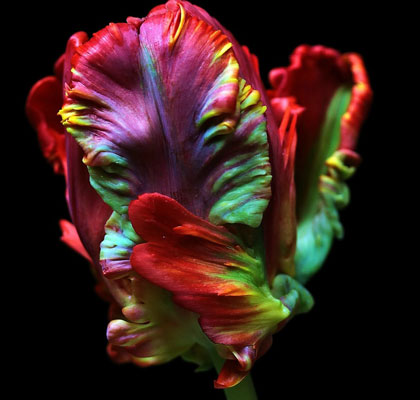Parrot Tulips Grow & Care Guide
Written by Iris
Dec 11 2021
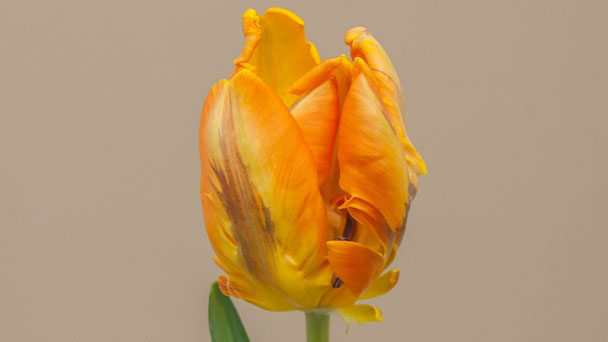
Parrot tulip, Tulipa gesneriana var. Dracontia is an attractive cultivar whose curly and pleated petals are interspersed with vivid color combinations. People are familiar with Parrot Tulips, whose colorful flowers herald the coming of spring. In this article, we will highlight the unique qualities of the parrot tulip and provide tips for growing this spectacular flower successfully.
For spring blooms, you'll need to start preparing to plant in the fall. You need your bulbs in the ground before the first ground frost of the season, since frost hardens the soil and makes it much more difficult to plant. You can find the approximate date of the first frost in your area by looking at any gardening almanac and calculate your planting date accordingly.
It's not a good idea to plant your Parrot Tulips too early, either — they may bloom before the first frost, at which point the frost would kill them off. The idea is to plant them in fall, allow them to lay dormant during winter, then watch them bloom in the spring.
If you've already missed the fall planting time, you can also plant your Parrot Tulips once the ground warms up in spring, though you’ll have to wait a while longer to see blooms.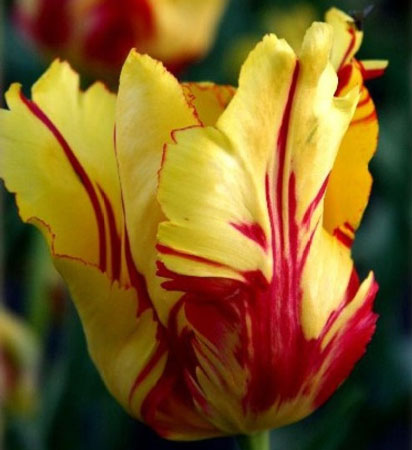
Gather seeds at the end of the blooming season once the tulip's oblong seed pod has dried out. Parrot Tulips seeds need cold to germinate and should be stored in the refrigerator during the summer months to chill before planting them in autumn. Keep them in a plastic bag with a slightly moist paper towel inside to keep them from drying out.
Start the Parrot Tulips seeds in autumn, as recommended by Fine Gardening, once nighttime temperatures fall to between 40 and 50 degrees Fahrenheit. It's best to start Parrot Tulips seeds in pots so you can better control their growing environment. Use 6-inch nursery pots with drainage holes at the base and rich potting soil. Prepare one pot for every five seeds you want to start. Fill the pots with soil. Sow the Parrot Tulips seeds at a depth of 1/2 inch. Space them a couple of inches apart and water deeply. During the winter months, place the pots outdoors near a lightly shaded south-facing wall and water whenever the soil feels dry just below the surface. Watch for the first sprouts in spring after daytime temperatures reach 60 degrees Fahrenheit.
Seed-propagated Parrot Tulips can take up to five to seven years to bloom, so you'll have to wait a long time to see what color and shape the flowers will be. Grow the seedlings in their pot for one to two years, during which time they will produce small bulbs. Transplant the bulbs into a sunny garden bed in autumn of their second year.
Prepare a planting site once soil temperatures dip below 55 degrees Fahrenheit, and nighttime air temperatures fall to between 40 and 50 degrees Fahrenheit. Choose a sunny garden bed with fast-draining soil. parrot tulips bulbs should be spaced 1 to 6 inches apart in garden beds, so choose a planting location with enough space to accommodate all of the bulbs you intend to plant. Closer spacing – between 1/4 and 1/2 inch between plants – is best for growing tulip cut flowers.
Loosen the soil to a depth of 8 to 12 inches and amend it with a few inches of compost, if the soil is poor. Parrot Tulips bulbs must be buried deep in order for them to bloom, so dig an 8-inch-deep planting hole for each bulb. Nestle the bulbs into the planting holes with the pointed end facing the sky and the broad base pressed against the soil. Water well. Watch for growth in early spring.
Parrot Tulips bulbs will eventually stop performing well as they become overcrowded in their bed. The bulbs need to be divided and re-propagated every three to five years to keep them blooming.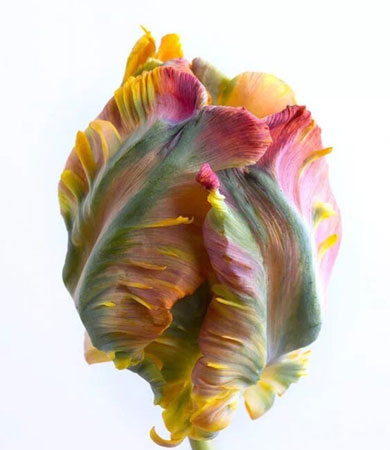
If you intend to grow Parrot Tulips on for a second year or more, it would help to top dress Tulip plantings with a 4-10-6 or 5-10-5 organic granular fertilizer three times a year. To top dress means to broadcast the fertilizer like one would cast birdseed, at the rate of about one teaspoon per bulb. First, top dress the fertilizer in the fall to promote root growth. Second, fertilize in the spring when the sprouts emerge to help grow the foliage and flower, and third, when the flower starts to die back to help nourish the bulb itself. If there is a prolonged dry period after fertilizing, you may water it in lightly.
Bone meal is not recommended because it can attract animals and it is incomplete nutritionally. (The 4-10-6 fertilizer composition refers to 4 parts nitrogen, 10 parts phosphorus and 6 parts potassium.) Avoid root burn by never adding anything to the planting holes.
Brown spots of dead tissue on leaves may indicate Parrot Tulips fire disease. In severe cases the spots enlarge and extensive areas become brown and withered giving the impression of fire scorch.
Tulip viruses are indicated by streaked and distorted leaves and flowers.
Tulip grey bulb rot is caused by Sclerotium (Rhizoctonia) tuliparum. It is one of the sclerotinia diseases but it is more commonly described as rhizoctonia disease. Prompt removal of infected bulbs is very important and the only means of control. Do not replant bulbs in the infected area for five years.
Bulbs in store can be affected by blue mould rot.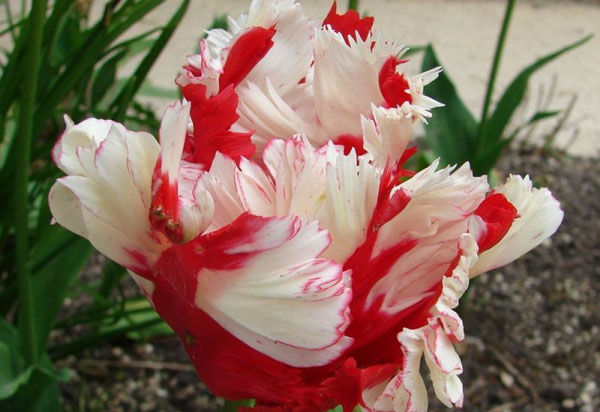
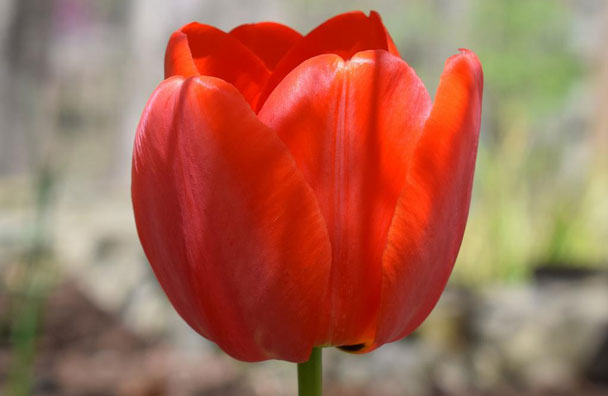
| Botanical/Scientific Name | Tulipa gesneriana var. Dracontia |
| Common Name | Parrot tulip |
| Plant Type | Perennial |
| Light Requirements | Full sun |
| Soil Requirements | Moist, well-drained |
| Flower Color | Range from nearly black to orange, pink, purple, red, white, and yellow, as well as multicolored variations |
| Bloom Time | Spring, Summer, Fall |
| Planting Time | Early Spring |
Where to Grow Parrot TulipsWhen to Grow Parrot TulipsHow to Grow Parrot TulipsGrow Parrot Tulips from SeedsGrow Parrot Tulips from BulbsHow to Care for Parrot TulipsParrot Tulips Lighting RequirementsParrot Tulips Soil CareParrot Tulips WateringParrot Tulips Temperature & Humidity CareParrot Tulips FertilizerParrot Tulips PruningParrot Tulips Pests & Diseases CareParrot Tulips VarietiesParrot Tulips Care FAQWhy Are Parrot Tulip Bulbs Being Dug Up?Do Parrot Tulips Bloom More Than Once?Why Do Parrot Tulips Not Blooms?
Where to Grow Parrot Tulips
Parrot tulips are more delicate than other tulips species. It is best to plant parrot tulips away from strong wind, possibly even potting them, to allowing for bringing them indoors out of the wind. The bulbs must be 5 inches deep, and around 4 to 6 inches deep. Be sure to find a place in full sun, and most importantly is well-drained soil. Parrot Tulips hate wet feet.When to Grow Parrot Tulips
The proper timing depends on the specific variety of Parrot Tulips. However, many people love to grow standard tulips because they’re one of the first flowers to bloom in Spring, providing a much-needed burst of color after a long winter. If you’re planting one of these standard varieties of Parrot Tulips, follow these guidelines for the proper timing.For spring blooms, you'll need to start preparing to plant in the fall. You need your bulbs in the ground before the first ground frost of the season, since frost hardens the soil and makes it much more difficult to plant. You can find the approximate date of the first frost in your area by looking at any gardening almanac and calculate your planting date accordingly.
It's not a good idea to plant your Parrot Tulips too early, either — they may bloom before the first frost, at which point the frost would kill them off. The idea is to plant them in fall, allow them to lay dormant during winter, then watch them bloom in the spring.
If you've already missed the fall planting time, you can also plant your Parrot Tulips once the ground warms up in spring, though you’ll have to wait a while longer to see blooms.

How to Grow Parrot Tulips
Grow Parrot Tulips from Seeds
Growing Parrot Tulips from seeds is uncommon. Tulip plants hybridize easily, and their seeds typically don't produce flowers that resemble those of the parent plant. However, if you're looking to experiment or perhaps discover a whole new variety of Parrot Tulips, then tulip seed propagation could be a worthwhile project.Gather seeds at the end of the blooming season once the tulip's oblong seed pod has dried out. Parrot Tulips seeds need cold to germinate and should be stored in the refrigerator during the summer months to chill before planting them in autumn. Keep them in a plastic bag with a slightly moist paper towel inside to keep them from drying out.
Start the Parrot Tulips seeds in autumn, as recommended by Fine Gardening, once nighttime temperatures fall to between 40 and 50 degrees Fahrenheit. It's best to start Parrot Tulips seeds in pots so you can better control their growing environment. Use 6-inch nursery pots with drainage holes at the base and rich potting soil. Prepare one pot for every five seeds you want to start. Fill the pots with soil. Sow the Parrot Tulips seeds at a depth of 1/2 inch. Space them a couple of inches apart and water deeply. During the winter months, place the pots outdoors near a lightly shaded south-facing wall and water whenever the soil feels dry just below the surface. Watch for the first sprouts in spring after daytime temperatures reach 60 degrees Fahrenheit.
Seed-propagated Parrot Tulips can take up to five to seven years to bloom, so you'll have to wait a long time to see what color and shape the flowers will be. Grow the seedlings in their pot for one to two years, during which time they will produce small bulbs. Transplant the bulbs into a sunny garden bed in autumn of their second year.
Grow Parrot Tulips from Bulbs
Parrot Tulips propagation from bulbs is a simple process, but it must be done at the right time of year and under the right conditions to produce healthy plants. Autumn is the best time to propagate tParrot Tulips from bulbs because the bulbs require a lengthy chilling period before they will bloom. In warmer climates where winters are mild, such as in U.S. Department of Agriculture plant hardiness zones 8 to 10, gardeners may need to store the bulbs in the refrigerator for six to 12 weeks to induce blooming the following spring, according to Johnny's Selected Seeds. Avoid storing tulip bulbs near ripe fruit because the ethylene gas released by the fruit may cause the bulbs to fail.Prepare a planting site once soil temperatures dip below 55 degrees Fahrenheit, and nighttime air temperatures fall to between 40 and 50 degrees Fahrenheit. Choose a sunny garden bed with fast-draining soil. parrot tulips bulbs should be spaced 1 to 6 inches apart in garden beds, so choose a planting location with enough space to accommodate all of the bulbs you intend to plant. Closer spacing – between 1/4 and 1/2 inch between plants – is best for growing tulip cut flowers.
Loosen the soil to a depth of 8 to 12 inches and amend it with a few inches of compost, if the soil is poor. Parrot Tulips bulbs must be buried deep in order for them to bloom, so dig an 8-inch-deep planting hole for each bulb. Nestle the bulbs into the planting holes with the pointed end facing the sky and the broad base pressed against the soil. Water well. Watch for growth in early spring.
Parrot Tulips bulbs will eventually stop performing well as they become overcrowded in their bed. The bulbs need to be divided and re-propagated every three to five years to keep them blooming.

How to Care for Parrot Tulips
Parrot Tulips Lighting Requirements
Equal to the requirements for the most other famous tulips varieties, parrot tulip plants need full sun. Full sun means that they need to receive sunlight for a large portion of the day. The part caring for tulips that needs the most balance is the amount of sun in ratio with the amount of water. When this balance is just right, you will have beautiful, bright, healthy crops of tulips to delight your eyes.Parrot Tulips Soil Care
The parrot tulip will grow best in well-drained acid, alkaline, or neutral soil with a pH of 6-7.Parrot Tulips Watering
Be sure that your soil is moderately moist. Once you plant your Parrot Tulips bulbs, they should be thoroughly watered, but that is the only time they will require heavy watering. If it rains once a week where you live, then no additional watering is needed. If you experience a long dry spell, your plants should be watered once a week. Heavy rains and wet soil will cause the plants to rot.Parrot Tulips Temperature & Humidity Care
Generally speaking, parrot tulips are not as tolerant of temperature extremes as some other varieties of spring bulbs. They also cannot withstand high winds or drenching rain, though their stems have become considerably stronger than they once were due to continued cultivation. When heavy storms are predicted, you can save your plants by covering them with large, lightweight containers (ideally weighed down with bricks or rocks).Parrot Tulips Fertilizer
The truth is that the Parrot Tulips bulbs you receive from us are perfect little packages that contain everything they need for glorious blooms the following spring. Just make sure to plant according to instructions.If you intend to grow Parrot Tulips on for a second year or more, it would help to top dress Tulip plantings with a 4-10-6 or 5-10-5 organic granular fertilizer three times a year. To top dress means to broadcast the fertilizer like one would cast birdseed, at the rate of about one teaspoon per bulb. First, top dress the fertilizer in the fall to promote root growth. Second, fertilize in the spring when the sprouts emerge to help grow the foliage and flower, and third, when the flower starts to die back to help nourish the bulb itself. If there is a prolonged dry period after fertilizing, you may water it in lightly.
Bone meal is not recommended because it can attract animals and it is incomplete nutritionally. (The 4-10-6 fertilizer composition refers to 4 parts nitrogen, 10 parts phosphorus and 6 parts potassium.) Avoid root burn by never adding anything to the planting holes.
Parrot Tulips Pruning
If they've been grown as perennials, be sure to cover these plants with mulch after the foliage dies. If you're planting parrot tulips as annuals, you can lift them when they've finished blooming and plant new bulbs in the fall.Parrot Tulips Pests & Diseases Care
Aphids can develop on stored bulbs, as well as during the growing season, and can spread viruses. Holes in leaves and bulbs during early spring may be due to slugs. Stem eelworm is an infrequent problem that can cause distorted growth and malformed flowers.Brown spots of dead tissue on leaves may indicate Parrot Tulips fire disease. In severe cases the spots enlarge and extensive areas become brown and withered giving the impression of fire scorch.
Tulip viruses are indicated by streaked and distorted leaves and flowers.
Tulip grey bulb rot is caused by Sclerotium (Rhizoctonia) tuliparum. It is one of the sclerotinia diseases but it is more commonly described as rhizoctonia disease. Prompt removal of infected bulbs is very important and the only means of control. Do not replant bulbs in the infected area for five years.
Bulbs in store can be affected by blue mould rot.

Parrot Tulips Varieties
There are more than 50 different cultivars of T. gesneriana var. dracontia, in colors that range from nearly black to orange, pink, purple, red, white, and yellow, as well as multicolored variations.- Apricot Parrot
- Black Parrot
- Blue Parrot
- Rococo

Parrot Tulips Care FAQ
Why Are Parrot Tulip Bulbs Being Dug Up?
Animals are a very common foe of Parrot Tulips. Deer, squirrels and other rodents will often dig up the bulbs to feast on, but you can take some precautions to prevent this from happening. When planting the bulbs, plant daffodils throughout the area as well — animals avoid eating them. You can also plant the bulbs with a cage or chicken wire surrounding them.Do Parrot Tulips Bloom More Than Once?
Parrot Tulips are a perennial plant, meaning they will bloom every year. However, some hybrids are not as hardy and will likely need to be replanted the following year. It’s also important to note that if you live in an area where the ground will not dip to temperatures below 55 degrees Fahrenheit, you will need to replant the Parrot Tulips every year since the bulbs need several weeks to chill. (Read more about Tulips Bloom More Than Once.)Why Do Parrot Tulips Not Blooms?
The most common reason for having non-flowering plants is that the environmental requirements haven't been met. Be sure that the soil is a low enough temperature when planting Parrot Tulips, and avoid planting in soil that is too wet. It is also possible that an animal has damaged the bulb by trying to eat it, causing leaves to appear without blooms.Latest Updated
- Benefits of Bugleweed - 7 Science-backed Health Benefits
- Bugleweed Dangers & Side Effects - Is It Poisonous?
- How to Plant Evergreen Trees - What You Should Know
- When to Plant Evergreens - Grow Guide for Evergreen Trees
- 12 Wonderful Evergreen Shrubs for Your Garden
- 12 Popular Evergreen Plants with Pictures for Beginners
- When And How To Prune A Lilac Bush Like a Pro
- How to Grow & Care for Lilac Vine (Hardenbergia Violacea)
- Japanese Lilac Tree (Syringa Reticulata) Care & Propagation Guide
- Shumard Oak Pros and Cons - What to Know
Popular Articles
- Winter maintenance of Antirrhinum Majus
- How to Grow Terminalia Mantaly Tree
- How to Grow and Care for Crossostephium Chinense
- How to grow Antirrhinum Majus in spring
- Peristeria Elata (Dove Orchid) Profile: Info & Care Guide
- Underwatered Snake Plant (Sansevieria Trifasciata) - Signs And How To Fix
- How to Care for Brazilian Jasmine Plant (Mandevilla Sanderi)
- How to Grow & Care for Graptopetalum Purple Delight in Summer
- Rosa Chinensis (China Rose): Plant Growing & Care Tips
- How to Care for Baby Sun Rose (Aptenia Cordifolia)
